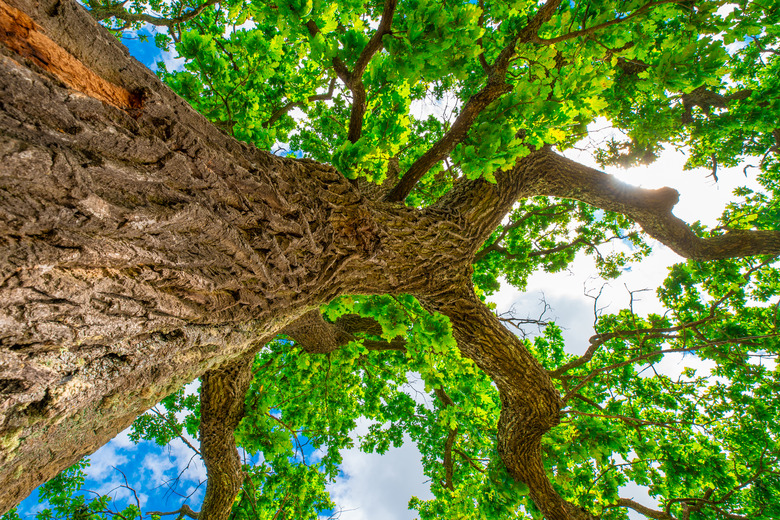How To Age A Live Oak Tree
We may receive a commission on purchases made from links.
The aging live oak (Quercus virginiana) tree in your yard took years to evolve, with its numerous branches bending toward the earth before shooting upward. Resembling a runner in the blocks waiting for the starting gun to go off, the live oak is one of the statelier trees grown in the South. U.S. Department of Agriculture plant hardiness zones 8 through 10 are ideal for live oaks and, as the scientific name suggests, healthy trees can be found from Virginia south through Florida and west to Texas and Oklahoma.
Characteristics of the Live Oak
Characteristics of the Live Oak
You know you're in the South when you see majestic trees with shorter trunks and branches almost touching the ground. Spanish moss draped over the limbs is a sure sign that the live oak that you're looking at is a native of the South. With a height of up to 80 feet and a branch spread even larger, some measuring 60 to 100 feet, it's natural to want to know how old that tree is. The truth is, some live oaks are hundreds of years old, with some even approaching 500 years.
Durable and Hardy
Durable and Hardy
The live oak is the hardest and most dense lumber found in all oak species. Having an ability to withstand saltwater without it eating away at the surface, it's no wonder that the Navy commissioned their ships to be built of live oak after the Revolutionary War, according to the U.S. Naval Institution. Its curving branches allowed ship construction to have limited joining pieces. While the curves made live oak unsuitable for floor planking, it was ideal for shipbuilding.
Building With Live Oak
Building With Live Oak
The wood of a live oak is incredibly strong, but most trees are not used for lumber any longer. It's interesting to note that live oak lumber was used in the construction of a ship named the Constitution. The ship was built in the dockyards of South Carolina, where live oaks were harvested, and the wood was used to frame the frigate. Legend is that during the War of 1812, cannonballs fired at the ship bounced off its sides; thus the name "Old Ironsides" was given to the Constitution.
Age a Live Oak Tree
Age a Live Oak Tree
If your live oak tree has a substantial circumference, you'll need someone to help you measure it.
Mark a spot on the trunk about 5 feet from the ground. Be sure there are no knobs or bumps and that the trunk is smooth around the circumference. Run the tape measure completely around the trunk and make sure the tape is level throughout. Enter the number of inches into a calculator. The same steps are used for aging other trees, and some use a growth factor when calculating age.
Calculate the Trunk Diameter
Calculate the Trunk Diameter
The number of inches of circumference divided by pi (3.1416) gives you the diameter of the trunk. For example, if the circumference is 200 inches, divided by 3.1416, the diameter is approximately 64 inches.
Estimate Using the Growth Factor
Estimate Using the Growth Factor
Most estimates of age use a growth factor of the specific type of tree. While the number is easily found for most oaks, the live oak's growth factor remains an unanswered question. It is suggested that when estimating the age using the growth factor, to use the number 4 if it's an unknown. Multiply the diameter by the growth factor. In this example, 64 x 4 = 256 years old.
Growing conditions, air, soil quality, insect remediation and a host of other factors contribute to estimating the age of a live oak, and often it's difficult to get a tape measure around the trunk because of its variations in shape. Just know that the gnarlier the tree is and the more limbs are coming off the trunk, the older it is.
